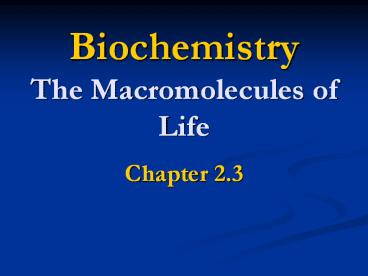Biochemistry The Macromolecules of Life - PowerPoint PPT Presentation
1 / 26
Title:
Biochemistry The Macromolecules of Life
Description:
Biochemistry The Macromolecules of Life Chapter 2.3 Organic Chemistry The study of all compounds that have bonds between carbon atoms. Importance of Carbon Carbon has ... – PowerPoint PPT presentation
Number of Views:269
Avg rating:3.0/5.0
Title: Biochemistry The Macromolecules of Life
1
BiochemistryThe Macromolecules of Life
- Chapter 2.3
2
Organic Chemistry
- The study of all compounds that have bonds
between carbon atoms.
3
Importance of Carbon
- Carbon has 4 valence electrons
- It tends to form covalent bonds with other carbon
atoms
4
- In doing so, carbon can form a variety of shapes
5
chains
6
rings
7
branches
8
- or combinations of chains, rings, and branches.
9
Macromolecules
- Carbon is able to form large and complex
molecules called macromolecules
10
- Macromolecules are made by polymerization in
which small compounds (called monomers) are put
together to make larger compounds (called
polymers)
11
- There are 4 types of organic macro-molecules
(organic polymers) - Carbohydrates
- Lipids
- Proteins
- Nucleic Acids
12
Carbohydratessugars
- Made of C, H, O in a 21 (HO) ratio Ex C6H12O6
- Monomer is
monosaccharide
13
(No Transcript)
14
- Glucose quick energy
- Starch plant storage
- Glycogen animal storage
- Cellulose structure in plants
- Chitin exoskeleton in crayfish, etc
15
- Examples include galactose, fructose,
polysaccharides (like starch and cellulose) - Used as the main source of fuel and/or structural
purposes
- Found in breads, cereals,
- pasta, potatoes, corn
16
Lipids fats
- Made of mostly of C and H and O
- Monomer is glycerol attached to fatty acids
17
(No Transcript)
18
- Used to store energy, make cell membranes,
waterproof coverings - Examples saturated fats, unsaturated fats,
polyunsaturated fats, oils, waxes, cholesterol,
steroids
19
- Contained in dairy products,
- meats, some vegetables
20
Nucleic Acids
- Made of C, H, O, N, P
- Monomers are nucleotides
21
(No Transcript)
22
- Used to store and transmit genetic information
- Examples include DNA and RNA
- Found in any food that contains cells
23
Proteins
- Contains C, H, O, N (S, P)
- Monomers are amino acids
24
(No Transcript)
25
- Used to regulate chemical reactions and cell
processes, form body structures, transport
materials, or fight disease
26
- Examples include enzymes, antibodies, muscle
tissue - Contained in meats, legumes, dairy products































